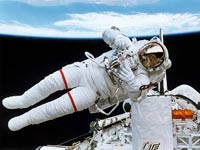Metal shavings cause solar-panel problems, astronauts report
Spacewalking astronauts doing construction work outside the international space station made a disturbing discovery: what appear to be metal shavings inside a joint that is needed to turn a set of solar power panels.

The rotary joint, 10 feet (3 meters) in diameter, has experienced intermittent vibrations and power spikes for nearly two months. Space station managers were hoping a thermal cover or bolt might be hanging up the mechanism, which would have been relatively easy to fix, and were disheartened Sunday when Daniel Tani radioed down that metal shavings were everywhere.
"It's quite clear that it's metal-to-metal grating or something, and it's widespread," Tani said.
"Wow," said his spacewalking partner, Scott Parazynski.
The shavings resembled small flakes and were clinging to the joint as if to a magnet, Tani said. "It looks like a dusty table that you'd want to dust at home," he called down.
The astronaut used tape to dab up some of the shavings. It will be returned to Earth aboard Discovery next week for analysis. NASA is uncertain whether the flecks are actually metallic, possibly from the aluminum foil lining the thermal covers, or some other material.
This rotary joint, launched and installed just four months ago, controls the huge solar panel wings on the right side of the space station, to make sure they are facing the sun. The joint for the left solar wings is working fine.
The right rotary joint will remain in a parked position as much as possible until the problem is solved, said Mike Suffredini, NASA's space station program manager. Flight controllers were trying to determine whether any more inspections or even repairs will be needed in the coming week, or whether they can continue to work around the problem following Discovery's departure.
The astronauts have spare parts for the joint with them in orbit, including extra bearings.
It is possible that the debris, whatever it is, could cause permanent damage, Suffredini said. Another possibility is that the joint could stall in a position that would diminish solar power. That's why he intends to move it as little as possible, for now.
It was too soon to know whether the joint - if it continues to malfunction - would affect science operations aboard the European laboratory that is scheduled to fly to the space station in December, or the Japanese lab that will follow, Suffredini said.
"We have lots of time to work through this problem. It's not an immediate issue," Suffredini said at a news conference Sunday afternoon following the spacewalk.
The problem overshadowed the rest of Sunday's spacewalk, the second of five planned for Discovery's construction mission.
Subscribe to Pravda.Ru Telegram channel, Facebook, RSS!


